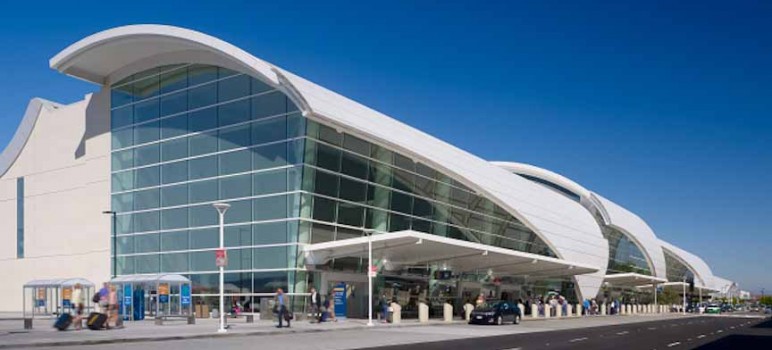When you have a San Jose City Council policy that is an exception to the Municipal Code, and then when the airport carries it further and claims they have an exception to the council policy, it becomes absurd and appears that there are no rules. Let’s explain how this applies to billboards at the Norman Mineta San Jose International Airport near HWY 101 and the Guadalupe River Trail…
City rules about signs are codified in the Municipal Code, an extensive document with 27 titles and hundreds of chapters. The code also contains a title devoted to all aspects of airport planning and operation. Instead of revising that code, which is broadly considered the go-to reference for city rules and processes, the city council in 2018 (with no significant public engagement) created a separate policy called Council Policy 6-4 that says when it come to billboards on city property (especially at the airport) much of the municipal code does not apply.
That’s like having two sets of books, one for the public to see and one deceptively designed as a municipal code work-around to satisfy the billboard lobby, negate the 35-year ban on new billboards, and allow 22 or more digital billboards on landmark buildings downtown and on freeway facing property at the airport and elsewhere.
Today we face the prospect of the city’s first new billboards as part of the “US 101 Airport Electronic Sign Project” and we see how bending the rules has been the hallmark theme fueling the effort to force new digital billboards on San Jose despite well-documented and widespread public opposition.
For the airport project, instead of following the legacy code that limits billboards to 500 square feet, the plan using the council policy exception calls for new billboards along the Guadalupe River Trail to be 1,000-square-foot behemoths towering 60 feet in the air. Instead of conforming to the existing Municipal Code that limits programmable signs to on-site and non-commercial messages unless “explicitly allowed in this title,” the airport plan again bypasses the codified rules and proposes installation of giant billboards flaunting commercial advertising for national brands.
The 2018 City Council Policy 6-4 appeared to have reasonable processes and perhaps lofty goals in some proponents’ minds to reduce blight by taking down static billboards at a 4:1 ratio for each new digital billboard constructed. However, the reality of the airport billboard project in 2021 is far from the spirit of that policy and yet another example of blatant accountability-avoidance and disrespect for policy.
Specifically, Council Policy 6-4 calls for competitive bidding and a request for proposal (RFP) process, but airport staff ignored that best-practice public interest protection, insisting that such niceties don’t apply to “their” billboard project. That viewpoint is aptly expressed by Rebekah Bray, the airport’s acting senior property manager who asserted such independence in an email that noted, “In August 2019, the city went out for 2 RFPs for outdoor advertising and…we carved out the airport stating that we intended to do our own program for outdoor advertising.”
Forgoing the competitive bidding process entirely, airport staff assert that they are free to amend a 2007 concessionaire agreement with Clear Channel Outdoor to include the four 1,000-square-foot billboards proposed at the airport even though the city council’s 2018 misguided approval allowing digitals was then eight years in the future.
Not to be overlooked is the airport’s remarkable claim that it is excluded from the 4:1 static billboard takedown requirement even though that requirement was the major talking point expressed repeatedly by digital billboard proponents angling to reverse the ban on new billboards. Flouting this key plank in Council Policy 6-4, and anxious to bow to Clear Channel’s every wish, airport staff crafted a deal to remove only two static billboards for each new digital, and they don’t even have to be in the city of San Jose!
Such contemptuous rule-bending, rationalizing, and reality-twisting maneuvers included violations of public engagement protocols. Worse yet, a convoluted process that updated the Airport Master Plan EIR subjected every aspect of airport operations to strict scrutiny but conveniently omitted any reference to billboards, raising concerns about blatant conflict of interest. Consequently, it is now time to revisit and rescind City Council policy 6-4 that started this fiasco.
Yes, it is time for a thorough review of the airport billboard project which we contend has been conducted with deception, a deliberate lack of transparency, and with the rogue arrogance of a powerful self-serving Airport fiefdom. It is time to recognize and heartily endorse the city’s own survey which showed 93% of more than 2,000 respondents oppose new billboards along freeways and 80% oppose new billboards Downtown.
It’s time for every San Jose City Council member to state clearly whether they are on the side of the public or the billboard lobby and whether they understand the extent to which Policy 6-4, an exception-filled cavalier override of municipal codes, was a theft of the public’s trust and confidence in the integrity of our elected and appointed officials.
Jason Hemp, Les Levitt and John Miller are founders of No Digital Billboards in San Jose.


Digital Bill-Boards are here to stay.
Actually, they are really “Jumbotron televisions” with exceptional resolution.
A Digital Bill-Board can sell advertising by the “second of display.”
The Airport finances could benefit from the taxes garnered from the income generated by the electronic Bill-Boards / Jumbotrons every second they are in operation.
The real creative use of engineering the Bill-Boards / Jumbotrons is to; mechanically rotate and or change the viewing angles during different times of the day and or night.
David S. Wall